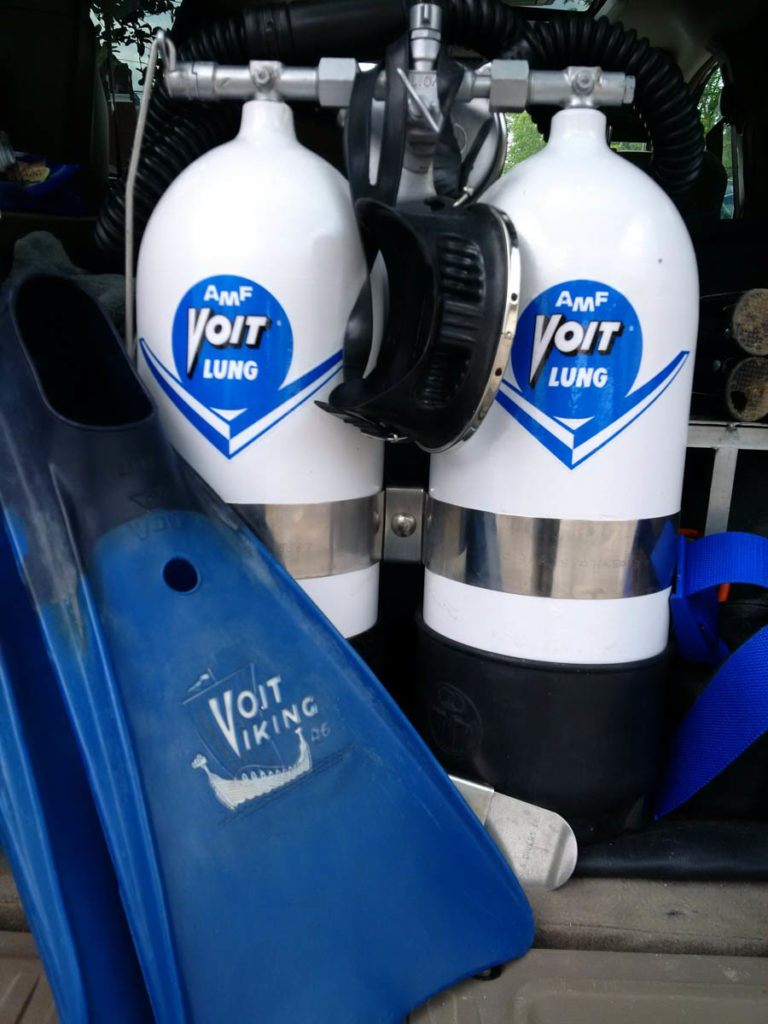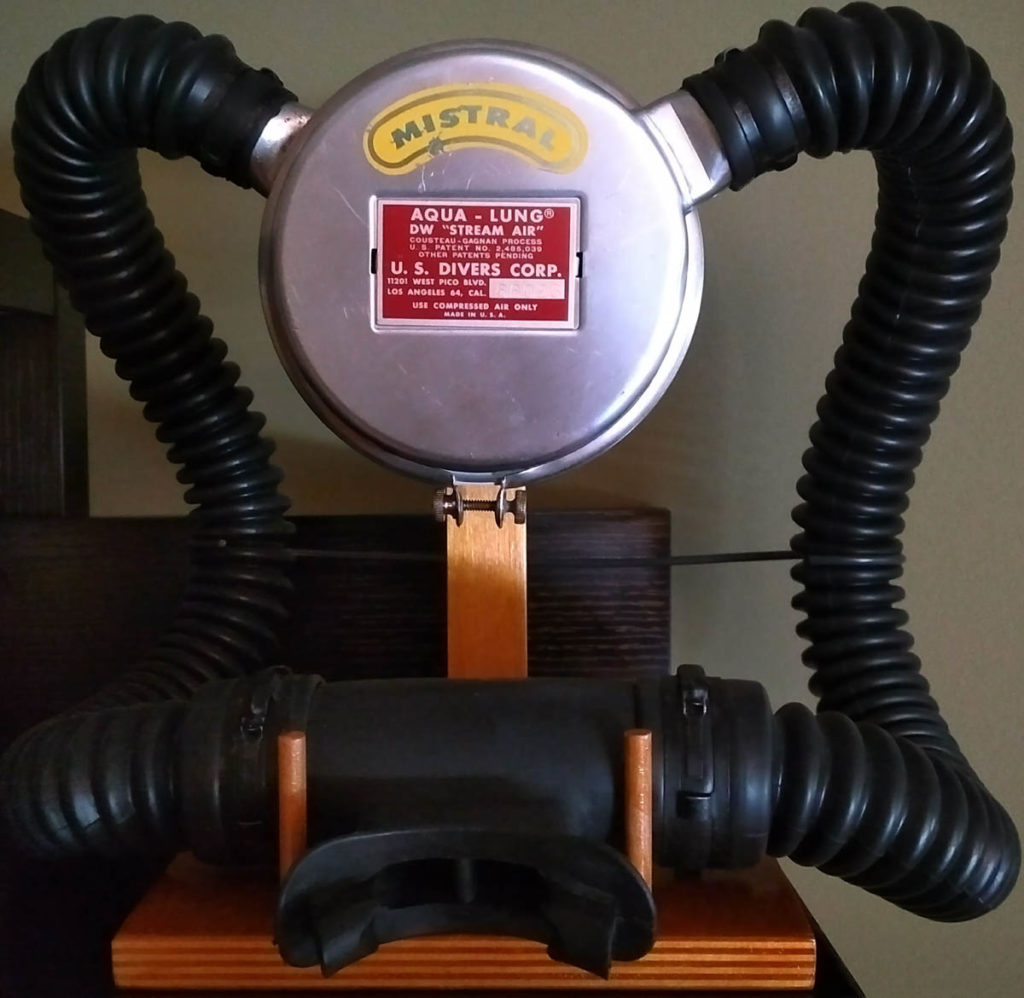Shortly after learning to dive in 2007 I was so hooked that I wanted to learn more about the sport. My interest turned to vintage diving while on a dive trip to Grand Cayman in 2010.
One of the divers on the dive boat was using odd-looking gear. Her regulator had large corrugated hoses. I originally thought it was a re-breather but soon realized it was a vintage diving regulator. She was a lawyer from Illinois who started diving vintage because some of her local dive buddies did. It was interesting to see her dive. She seemed to dive vintage style as well. Back then, it seems, divers didn’t have a “no touch” rule. She and her dive buddy were trying to pull a lobster from a crevice. Despite that I was curious about the equipment and was interested in trying it.
That same year the Kitchener-Waterloo Scuba Social had formed and shortly after my Cayman trip I met a fellow named Brian. I mentioned the vintage diver and he replied that he learned to dive on that equipment and still had his original double-hose regulator and other equipment. I learned a lot about vintage gear that night.

I had been keeping an “alert” on Kijiji for used dive gear and one day a listing for a vintage double-hose regulator appeared in my email so I bought it. It was a U.S. Divers Aqua Master, a two-stage vintage regulator, circa 1960s, it was a very popular model. I had originally thought it would be a good display piece but after mentioning the purchase to Brian he suggested I repair it and he offered his help. As it turns out there is a large enough interest in keeping these old regs working that there are companies who still supply parts, both old stock and new reproduction parts.
I’ve never serviced a scuba regulator before. I’ve taken one apart during a scuba hardware course but it wasn’t enough to understand them. I am a handy person and adventurous enough to experiment. With Brian’s help I decided on what replacement parts I’d order, about $150 worth. When they arrived Brian came over to help. In about two hours I had a tuned and working regulator.
There is a lot to know about old regulators. They were made when scuba tanks were typically 1,800 to 2,250 PSI. The regulators prior to the late ’60s didn’t have strong enough yokes to accommodate what, at the time, were known as high-pressure 3,000 PSI tanks. Some vintage yokes didn’t fit on today’s convertible valves. So there are compatibility issues dealing with vintage regulators. I had to scramble to find things that fit before I could dive it. Luckily I had an AL80 with an older valve. I bled the tank down to a suitable pressure.
Diving a double-hose is different enough that it requires some instruction. A double-hose regulator doesn’t have an octo (safe second), inflator ports, an SPG, or purge button. Depending on the specific regulator, adapters are available to connect an LP hose and an HP hose, but I didn’t have those on this dive. I was hesitant to jump into the water with a regulator that didn’t have any of those so I brought a pony bottle fitted with a modern regulator and inflator hose. That way I had an alternative source of air if there was a problem and I could inflate my wing easily.

There was something wrong with that first dive. Although I was diving a vintage regulator I wasn’t vintage diving. I had a modern backplate/wing and that didn’t mount the scuba tank in the right place. The tank was too high on the harness, which meant that while diving the regulator was positioned higher in the water column than it should be. This required more work to breathe than I was used to and that caused some issues. Not only did I tire of breathing quickly but the pressure difference squeezed my cheeks in, dug the old hard mouthpiece into my cheeks and caused my ears to pop in.
Brian said we needed to mount the tank lower. One of the main differences between single-hose and double-hose diving is that the demand diaphragm, which reacts to the change in pressure while inhaling to open the regulator valve and allow air flow. It is separated from the mouthpiece, where it’s located on single-hose regulators.
While diving a single-hose the diaphragm is always at the same level as the diver’s mouth so the difference in pressure is non-existent. With a double-hose the diaphragm is at the tank valve. So if the tank is mounted high, as we do with modern scuba, the diaphragm is positioned several inches higher in the water than the diver’s mouth and that small amount of pressure difference is noticeable.
Despite those issues on the first dive Brian led me through the skills needed to dive a double-hose regulator. Without a purge valve, clearing water from the regulator took extra consideration. Without an octo, air sharing meant buddy breathing and because of the double-hose it meant using a specific technique to pass the mouthpiece. The separation of the demand diaphragm and mouthpiece meant that when changing orientation in the water the reg could free-flow or be hard to breathe. These differences had to be experienced and practised to be safe diving a double-hose.
Over the course of several dives I tried different configurations. I purchased adapters so I could incorporate an SPG and an octo. I purchased used low-pressure steel 72-cubic-foot tanks with old valves, these old valves were small enough to accommodate the “banjo adapter” needed to attach an SPG.
Vintage diving is more than diving an old regulator. To truly experience it I needed to dive like it was done in 1960. That meant getting used to diving without some of the modern equipment I had been using. Equipment like BCDs and SPGs weren’t used in early diving. Instead of using a BCD divers would weight themselves very precisely and use their lungs to control buoyancy, breathing more deeply at the beginning of the dive when their full tanks were heavy and more shallowly when their nearly empty tanks were much lighter. On deeper dives separate weights would be used to descend. At the bottom, with neoprene wet suits crushed and less buoyant, the separate weights were ditched, only to be picked up at the end to use on ascent.
Without an SPG I would use various techniques to estimate tank pressure. The easy solution was to use a J-valve, so called because it was item “J” in the U.S. Divers catalog. The J-valve had a lever that would activate a reserve function. In the up position it would restrict air flow when the tank pressure dropped to a pre-set pressure, usually around 300 to 500 PSI. When breathing became hard I would reach behind, flip the lever and then end the dive. Some say this is where the 500 PSI rule came from.
J-valves were expensive and some divers used the K-valve (yes, item K in the catalog) and they would rely on other means to determine tank pressure. It is best to know one’s air consumption rate so you can time your dive to avoid running out of air. Regulators also reacted differently, some would become harder to breathe when tank pressure was low, others would free flow at low tank pressure. Once you became well attuned to the breathability you could get a feel for when the tank was near the 300 PSI limit, I have yet to master this.
Equipment was only one aspect of vintage diving. Training was another. I obtained a 1970s book “The New Science of Skin and Scuba Diving,” which contains what Brian described as the content of the original 20-plus week open water scuba course he took as a teenager. I was surprised to find that back then new divers had the equivalent of AOW, equipment, rescue, night and search and recovery training of today. I encourage new divers to obtain these specialty courses to be a more complete diver.
Over the years I’ve accumulated several different models and vintages of double-hose regulators and several different pieces of vintage equipment. I’ve graduated from diving just a vintage reg to diving a much more complete vintage kit and full vintage style. It’s nice to know where the activity I love came from, how divers used to train and how they used to dive. The pursuit of vintage diving has made me a better diver. I’m more familiar with regulator technology, better with buoyancy, and a more efficient diver. The diver I met in Grand Cayman and several small groups dive vintage for every dive they do. I’m happy with diving vintage in a more limited way. It’s a great way to re-realize how it was in the old days. It’s also a great conversation piece at dive sites. Finally it’s nice to help my close dive buddies feel what it was like to dive years ago.
Thank you John Van Ostrand for submitting this story.





